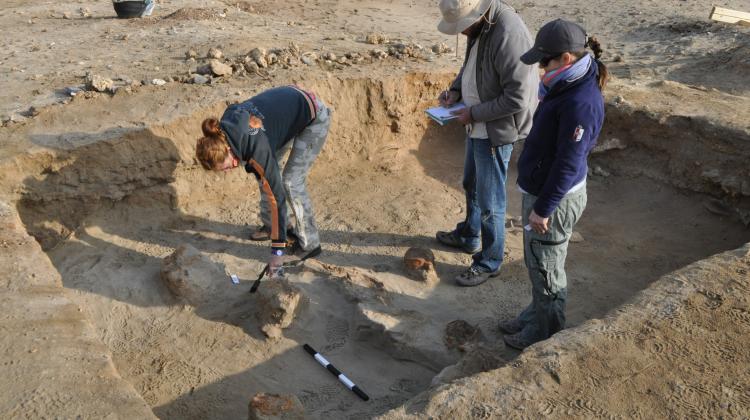New discoveries in Berenice
 PAP © 2012 /
PAP © 2012 /
Polish-American mission in Berenice on the Red Sea in Egypt discovered a previously unknown fort and temple building. This was the fifth season of archaeological work conducted in this place by Iwona Zych from the Centre of Mediterranean Archaeology of the University of Warsaw and Prof. Steven Sidebothama from the University of Delaware, according to the Centre of Mediterranean Archaeology press release.
In the western part of the site, after geophysical studies supplemented this season with excavations, archaeologists identified a large building. Until now, archaeologists have speculated that unspecified remnants found in this part of town are warehouse structures and workshops for handling sea expeditions. In view of recent studies scholars tend to define the structure as a fort, built in the earliest, early Hellenistic (1st half of the third century BC) phase of Berenice.
This year, archaeologists managed to discover the remains of a massive structure on a square plan, which can be interpreted as a corner tower of a larger structure. Tower footings were cut into the surface of natural rock. This allowed to accurately reproduce the structure plan. Archaeologists also reconstructed the way of setting and laying foundations.
Scientists were surprised to find near the walls abandoned damaged tools used during the construction work - a piece of stone whetstone possibly used for sharpening metal tools, which were used in foundation excavations, and a large animal shoulder blade with traces of wear on a wide top edge, probably used as a sand shovel.
Another new discovery, of the team of archaeologists is a temple complex at the entrance to the port bay. Several religious buildings had been known in Berenice, but this was the first time archaeologists uncovered a temple that was a part of a larger cult complex : they discovered remains of at least three buildings in the southern, port part of Berenice. Structures had been built in the fourth - fifth century AD.
Inside the complex, a large coral was found. According to archaeologists, it undoubtedly had a cultic significance. Archaeologists also discovered an "altar-column" and altars for burning incense. Votive objects were found nearby, some of which, including a bronze plaque depicting a bull\'s head, probably came from South Arabia.
"This would indicate long, South Arabian roots of religious rituals practised in the temple" - the researchers believe. Inside the temple they recorded traces of ritual feasts or sacrifices of meat, and bouquets brought to the temple. Botanical analysis indicated that in addition to lotus, found in the region, Yemen iris had also been brought to the temple. The flower had to be imported in the form of bulbs or cuttings. "This modest find is of utmost importance, as it also indicates the ties of the worship to the South Arabian region" - archaeologists believe.
Unique finds from the area of early Roman garbage dump, another place of study in Bernice, are two glass beads made in the millefiori technique (glass art with a floral pattern), depicting theatrical masks made in the first century AD. Masks of this type belong to the Roman luxury jewellery products. Rare finds include a wooden board with drilled hole for a string. It is probably a label that could identify the goods in two languages: Greek on one side, and perhaps Aramaic on the other. So far, archaeologists have not been able to decipher inscriptions.
Archaeologists also recovered plant remains from the garbage, including a well-preserved shell of coconut, which was transported to Bernice from India. Archaeobotanical matter also contained remains of flowers that do not occur in this region. "Undoubtedly, they had to be imported and grown in pots or find they way to Berenice in the form of bulbs or seeds" - archaeologists speculate.
Berenice on the Red Sea is an ancient port, entered by ships with the goods from India, Ceylon and South Arabia. The city was a refuge and a place of temporary residence for sailors, traders and people from the far corners of the world. It was the place where various languages and cultures were meeting.
PAP - Science and Scholarship in Poland
szz/ agt/ mrt/
tr. RL
Przed dodaniem komentarza prosimy o zapoznanie z Regulaminem forum serwisu Nauka w Polsce.
















